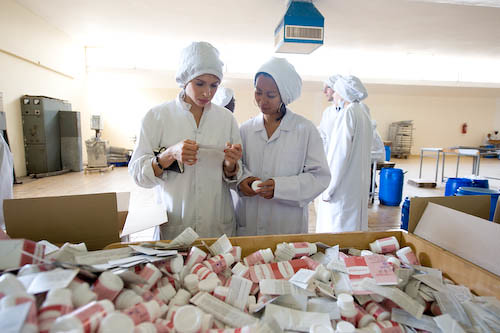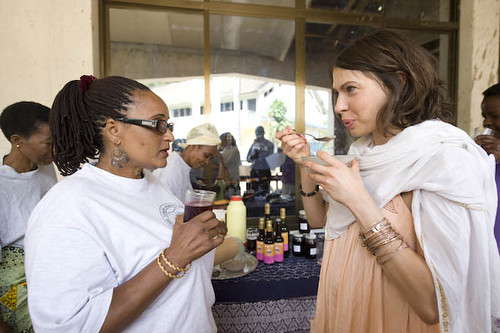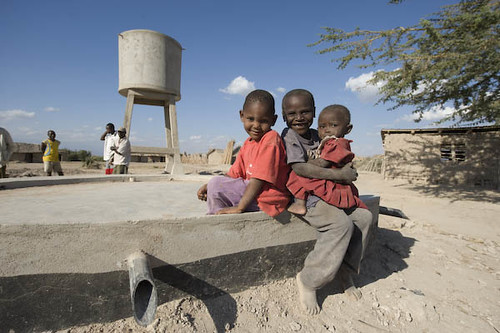To get us started here’s a review of a trip to Tanzania I went on with my beloved NGO ONE. We went to Arusha and Dar es Salaam in October 2009 (right after the German general elections) to study the progress being made in the fight against poverty. The post was originally published on the ONE blog.
Last week ONE Germany organized our first ever Africa trip. We took actress Minh-Khai Phan-Thi, actress and singer Jana Pallaske and musician Rea Garvey to Tanzania. Despite all the differences between the 48 countries South of the Sahara we think that Tanzania can be considered as a good example for much of Africa: the economy has shown steady growth, which is in part due to good governance; child and maternal mortality have dropped; Tanzania has made enormous progress in primary school enrollment. Only a few days after the German general elections and before the new government has been formed we wanted to show our guests how important targeted and effective development assistance is.
We started out on Tuesday morning in Arusha at two local health centers. In Tanzania medical treatment for pregnant women and children under five is free. So we wanted to find out what this meant for the women. At the first clinic we were astonished by the sheer lack of things: there were almost no supplies and even the lab’s only equipment was an old German microscope. But we also met Agnes, a mother of two, who benefitted from the government’s efforts to eradicate deaths through malaria. The clinic informed her of the disease and handed her a voucher to replace the family’s old net. At the second clinic we saw hundreds of women waiting for pre-natal examinations, birth, vaccinations for their newborns, contraceptives or HIV meds. We came to chat with a couple of the women and Dr. Solomon Ole, the district’s Health Coordinator.
Asked what they’d need most we received different answers – a building to protect the women from the weather, an ambulance, an incinerator. And I somehow understood why it’s called development corporation: it takes a good government to set plans to defeat disease and unnecessary deaths but it also takes donors to fulfill their promises to realize these.
In the afternoon we took a tour of Tanzania Pharmaceutical Industries. The company ventures to break Tanzania’s dependence on foreign pharmaceutics. Together with the NGO action medeor they’re building a new plant to produce ARVs.
Day 2 was rather hectic: we got up early in the morning to go to Moshi, nearby Mount Kilimanjaro, a couple of kilometers outside Arusha. We met with a lot of people who profited from an IFAD initiative. The women of Shiri Group had been introduced to a food processor: mangos, bananas, herbs, hibiscus flowers – all of these can only be stored for a couple of days, maybe weeks before they go bad. The food processor helps to dry the fruits, herbs and flowers in a rather easy process. But the women didn’t stop at producing for their own use. They’re also packing their goods and selling as far as Dar es Salaam. The 200 or so families organized in the mushroom group have even started to grow a crop previously unknown in the country. They’re growing Oyster mushrooms in small huts in their gardens. And while at first the hotels and restaurants that cater to tourists were the only customers Tanzanians have adopted the mushroom as well: they process it to jam, bread, samosas and so on.
The Muungano SACCOS is a micro credit facility financed by the borrowers themselves. Since 80 % of Tanzanians don’t have access to bank credits they rely on the Savings and Credit Cooperative Societies from which they buy shares; and should they need a credit they can borrow up to three times their deposit.
Water was the topic of the afternoon. We saw a project supported by German implementation organization KfW. Once finished the project will give 30 villages (or 100.000 people) access to drinking water. The spin that made it most interesting to us: sustainability – the villagers themselves have been included from the beginning. They decided where the water should come from and where the standpipes should go, they have to volunteer their time for trenching and carrying the pipes and the project team is also banking on Tanzanians to maintain the pipes and tanks.
After a stressful but inspirational day we had to rush to the airport to move on to the country’s unofficial capital Dar es Salaam.
Thursday started with education. We went to meet with parents, teachers, students and education activists at a primary school. First off we were struck by a simple logic: The government has made it its goal to grant every child in the country primary education. And as a matter of fact enrollment has risen to 98 % in just a few years. However, at which cost? At the school we went to the premises had been cut in half so that they now house two schools with each school having as many students as the one school before: more than 2,000. I was most intrigued by a 14 year old boy who was learning with 100 children in his class, 6 or 7 of them sharing a book, 4 of them sharing a desk that was made for 2: he spoke of the challenges getting an education meant for him and his family. But he also spoke of his dream of becoming a lawyer; which watching him speak I could believe instantly.
The afternoon of the third day we met with German development experts at the embassy to receive an outside / inside overview of development in Tanzania.
On our last day we went to see one of Tanzania’s largest tax payers: Twiga Cement. It was truly inspirational to see a company take corporate social responsibility as serious as the managers at Twiga do. But they were honest about saying that it’s also in their self-interest. Numbers proved them right: while their competitors showed only minor growth or even shrank in the last couple of years Twiga was able to increase sales by a third in a 2008 alone. Manager Pascal sent us on the way saying that there were some things that only development assistance could provide. But that it’s also on private entrepreneurship from locals and foreign investors alike to develop a country.
Then we went to see another water project. This time it was DAWASA who showed us how Dar es Salaam is trying to get a hold of the city’s water and sanitation problems. Since the city has grown and still is growing largely uncontrolled people have to buy from vendors or walk for miles for water. The sewer systems are often aged and don’t have enough capacity for city of 3 million.
We concluded the day with a dinner with Tanzanian personalities: Margaret Chacha, who only a few months ago founded the Tanzanian Women’s Bank, Banana Zorro, a very well known singer (later that night we even had a chance to see him and his father perform live on stage), Mrisho Mpoto, an illustrious poet and artist, and Rakesh Rajani, who has been involved in several NGOs to monitor and improve Tanzanian and African governments. Once again we received the message that it’s about development corporation not aid: everyone has to do their share – Tanzanians and donors alike.
The trip to Tanzania offered a multitude of impressions. We saw lots of progress but also lots of challenges. We saw how the people of Tanzania are proud of their country that beside the projects we saw has some of the world’s most impressive landscapes and wildlife. We saw potential that only wants an opportunity to prove itself.
All pictures in this post were taken by Marco Urban.





